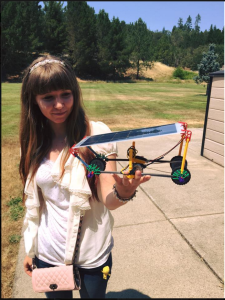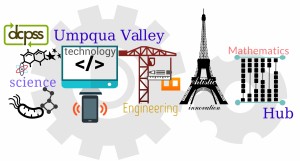
A solar-powered car is a great example of how creative design infuses science, technology, engineering or mathematics projects.
Art supplies cross-pollination
Without the artistic “A,” STEM can be a string of isolated subjects
Last summer, the Umpqua Valley STEAM Hub adopted a logo with symbols depicting the five letters and elements that comprise the group’s acronym. A computer screen atop a cell phone stands for the “T” in technology, for example, and an abacus resembling an “M” denotes mathematics.
Perhaps the most memorable icon is the A-shaped Eiffel Tower. That’s especially noteworthy, given that what it represents – artistic innovation and integration – is probably the most misunderstood of the quintet.
It’s true that the general public can have a hazy conception of the other elements of STEAM. Questionnaires reveal that many regard engineering as a highly specialized subject relevant only to architects with pocket-protectors. Science, meanwhile, is considered a catch-all term encompassing white coats, glass beakers and everything else that isn’t a math equation.
But it’s the arts piece of STEAM that we find people stumble over most often. How do the arts fit in with science, technology, engineering and mathematics? Why did we choose to call it the STEAM Hub instead of the STEM Hub?
Let’s talk first about what we don’t mean. The arts of STEAM are not found in museums and art history courses. Paintings, sculpture, mixed media installations and other creations play an absolutely vital role in our culture. But they don’t make up the arts piece of the STEAM puzzle.
Instead, the arts we’re emphasizing are all about the process that ties together ALL the elements of STEAM. They are the vision, energy, improvisation and creativity that an artist brings to solving a problem or seeking a solution to a challenge. They can be seen in what students of arts-based learning bring to group projects: greater insight, greater ability to identify a problem clearly, higher respect for others on the team and greater ease with sharing leadership. So artistic innovation becomes not only a bond between STEM disciplines, but also a lubricant.
We at DCPSS aren’t alone in this conclusion. Back in 2010, the National Science Teachers Association published a report called “Reaching Students Through the Arts.” One of the paper’s conclusions was that those who teach “science, technology, engineering and mathematics are discovering that by adding an ‘A’ – the arts – to STEM, learning will pick up STEAM.”
That’s not all. The National Science Foundation has funded the Art of Science Learning over the past three years, leading to a series of conferences to better understand the links between art and science. Far from being strictly an academic exercise, this art-science union has practical applications in the real world. One of the grant’s results has been the establishment of three arts-based incubators to address societal problems.
The incubators are based at San Diego’s Balboa Park Cultural Partnership, Chicago’s Museum of Science and Industry and the EcoTarium in Worcester, Massachusetts. Representatives of each location chose a civic challenge. For San Diego, this was California’s water shortage; for Chicago, hunger and nutritional deficits; for Worcester, lack of adequate transportation.
Following the blueprint of an initiative that explored the intersection of art, science and learning, the incubators came up with nearly two dozen ideas, many of them successfully marketed or set in motion within a year, to meet these challenges.
In San Diego, participants set up Trash to Paradise, a low-cost treatment plant using trash and artificial wetlands to transform wastewater into agricultural water. In Chicago, video producers combined forces to support Crunch Time: Teen Cuisine, a healthy cooking web show featuring short videos created and produced by teens. In Worcester, organizers set up a system called Tasks for Transit that converts volunteer hours into bus passes.
Here in Douglas County, the “A” in STEAM shows up in several ways. Recent competitions of the First Lego League and the Southern Oregon First Tech Challenge have featured student teams finding ways to design, build and program robots to complete tasks. If that meant modifying or scrapping a strategy that wasn’t working, kids had to pull together to find one that did.
Last summer, Oregon State University and Umpqua Community College teamed up again for Mobile Science and Engineering Camps. OSU’s Precollege Programs helped train UCC student instructors to carry out hands-on science and engineering activities with Douglas County middle school students. Activities emphasizing creative design were focused on renewable energy and included solar car engineering. The OSU/UCC camps series was one of several educational projects selected by the Umpqua Valley STEAM Hub to receive mini-grants to help create positive futures for Douglas County youth.
Our STEAM Hub shares the DCPSS goal of fostering activities and programs that help students learn to work in teams while still thinking independently. We believe that STEAM learning prepares students to solve problems and make good decisions. Ultimately, this ties into our larger mission of ensuring that each Douglas County student leaves high school with a workable plan for his or her future. And each plan should be tailored just for that student.
Art and science can come together to meet challenges anywhere, not just in San Diego, Chicago or Worcester. If you have ideas on how to infuse the “A” into STEM for the Umpqua Valley STEAM Hub, share them by going here. Let’s work together to develop student skills and habits that will serve them not only in their next classrooms or at their first jobs, but throughout their lives.
